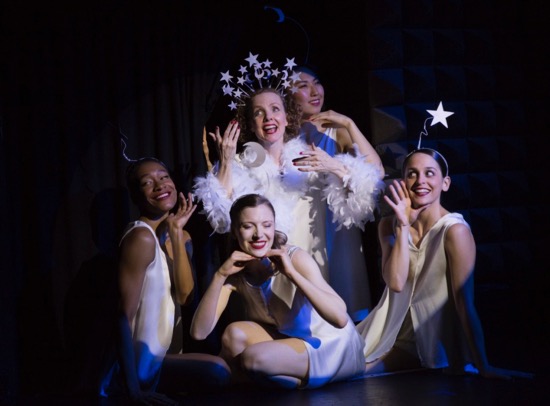
Megan Williams in her One Woman Show, surrounded by (clockwise from L): Kristen Foote, Megan Williams, Chelsea Hecht, Courtney Lopes, and Esmé Boyce. Photo: Yi-Chun Wu
I love going to shows at Joe’s Pub for Dance Now’s Dance-mopolitan’s Commissioned Artist Series. But doing so takes a kind of expertise that I may lack. Did I manage to cut the sticky burrata that topped my little salad while keeping clean the blank paper on which I intended to take notes? Check. Did I really order a second beer? Yes, I did. Did I actually take some notes on top of previous notes while keeping my eyes on what was happening on the tiny stage? So sue me.
The event: Megan Williams’s whip-smart, vastly entertaining One Woman Show is billed as a “post-postmodern dance theater follies for the small stage.” Songs and films of the 1930s, 1940s and beyond stir up images that jostle against memories and fantasies in Williams’s own life in this 21st century. That’s why she titled the performance as she did. But she’s not alone on the Pub’s wedge of a stage whose back wall looks like a shiny padded quilt—one that Lauren Parrish’s lighting can turn almost any color. Williams heads a cast of eight impressive others who’ve been seen more in dances by Merce Cunningham, Mark Morris, José Limón, and the like than in nightclub revues or Broadway shows.
Williams introduces her cast as the stars that they are, wearing headdresses by costume designer Barbara Erin Delo that sprout crescent moons and other heavenly bodies. She herself is crowned with a veritable starburst that looks just fine with her filmy, fake-ostrich-feather-trimmed coat, and she’s expert at occasional lip-synching. While she is swooning around with a chorus of contentious men, yes, that’s Judy Garland singing “Get Happy,” but there’s no way we can recognize all the voices (Danny Kaye, Debbie Reynolds, Rosemary Clooney) singing and speaking in the collage of items culled by sound designer-engineer Sam Crawford from movie history and nightclub hits . No matter. I get the drift and love the guys onstage: Robert Mark Burke, Derek Crescenti, Dylan Crossman, and John Eirich.
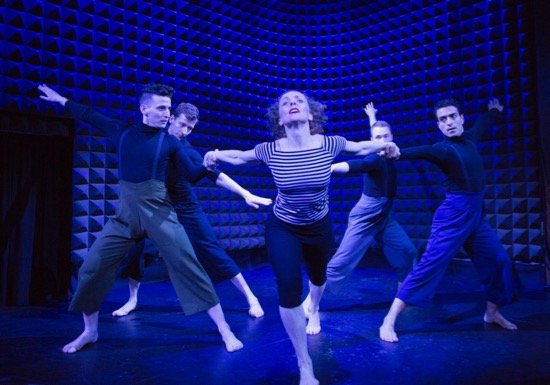
Megan Williams held back by (L to R): Robert Mark Burke, Dylan Crossman,
Derek Crescenti, andJohn Eirich. Photo: Yi-Chun Wu
Luckily for us, duets abound, and everyone gets plenty of attention. Crossman wafts a purple swath of fabric while Kristen Foote plays the exultant seductress and Josephine Baker sings “Rèves.” He seems to be trying to copy her, learn from her. Chelsea Hecht wears an apron to dance with Crescenti, while the Brian Sisters sing “How You Gonna Keep ‘Em Down on the Farm?” But while Kay Thompson and ensemble deliver “All or Nothing at All,” Courtney Lopes would as soon choke Burke and pick him up and drop him as do a bit of a slap and shuffle beside him. And Esmé Boyce and Eirich opt for a kind of Apache dance, in which mutual seduction is a goal.
The ingenious costumes play a role. I can’t recall just when everyone appeared in different makeshift ones, as if actors from a bunch of movies all arrived at the studio cafeteria together. Someone wears a lei; someone wields a fan; someone sports a cowboy hat. You know. . . .
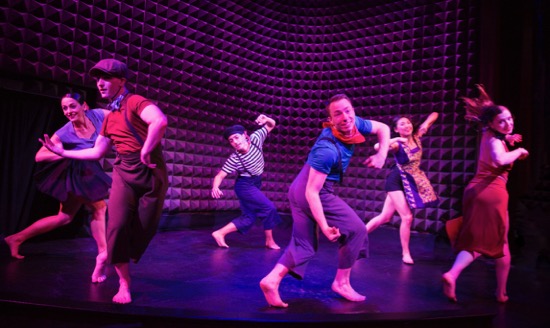
Megan Williams’s One Woman Show. L to R: Courtney Lopes, Robert Mark Burke, John Eirich, Derek Crescenti, Chelsea Hecht, and Esmé Boyce. Photo: Yi-Chun Wu
I marvel how Williams choreographed the group numbers so that eight people dancing energetically manage their circles and lines without bumping into one another. And, of course, they don’t always stay on the stage or maintain a “fourth wall.” Sometimes one or another enters or exits down the only aisle instead of disappearing into a lower level behind the curtain at the side-rear of the platform. And they enjoy crouching at the front of the stage to greet patrons at the tables practically at their feet. There’s always a tinge of irony to this puttin’ on a show. They really, really want to entertain us, but the glitzy aspect is tempered by their earnestness.
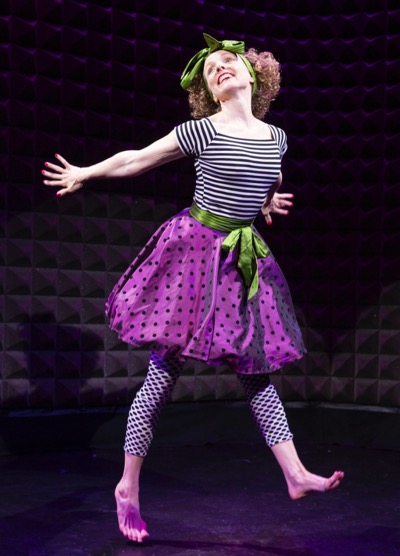
Megan Williams in her One Woman Show. Photo: Yi-Chun Wu
Early on, when Willams is dancing with the four men, they leave without her, and for a few moments, she’s alone onstage, slowly rolling over the floor, while a peppy male chorus sings. When she gets up, she has a serious look on her face, and when her fancy coat is brought on, she dons it and walks up the aisle and out of the space. Still, she reappears later with a big green bow on her head and a purple skirt (ruffled shorts underneath) adept at being ever so cute and slightly dysfunctional while we hear a dialogue, “Snooks (Why? Because!),” between Fanny Brice, as Baby Snooks, and Judy Garland in the 1938 film Everybody Sing. I seem to remember the line, “Big girls never cry.” Right. Three guys carry her off. Esme Boyce takes over the skirt for her solo. Later, Williams and Crossman dance together, now searchingly, now swooningly. She beckons him, attempts to hypnotize him. He lifts her. The end. Almost.
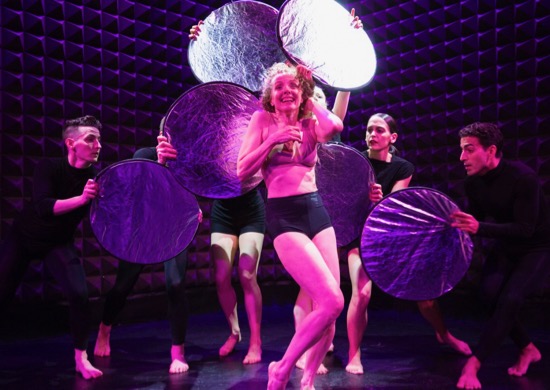
Star of the night Megan Williams, surrounded by her helpers. Visible L to R: Robert Mark Burke, Courtney Lopes, and John Eirich. Photo: Yi-Chun Wu
I may be losing the thread of this one woman’s memories, dreams, and experiences as it courses through these songs and dances. However, it’s gearing up toward the finale that every show needs. The four women, all in black, have been dancing, three men crawl in, the light turns magenta, a ratchety sound is heard. Then Williams emerges with a load of big disks and hands them out, and—Bright lights! Music!—she becomes a star again, ready to be framed, as if the disks were the petals of a big rose revealing her as its center, while snippets of dialogue from classic movies about strong women chase around them.
But wait, there’s more. Crossman appears in a sparkly silver suit. Foote, similarly glittering, joins him, and, one by one, the whole re-costumed cast enters the stage that’s been so full of recollections. Blue light, the sound of a broken record, but Duke Ellington’s orchestra plays on as stars twinkle on a little screen. And, lo, before us, a smiling, giving-it-out chorus line—if a very refined, indeed lovable one. It gets at the essence of a chorus line, meaning it takes a lot of people to make a life. I mean a show. I mean a life.
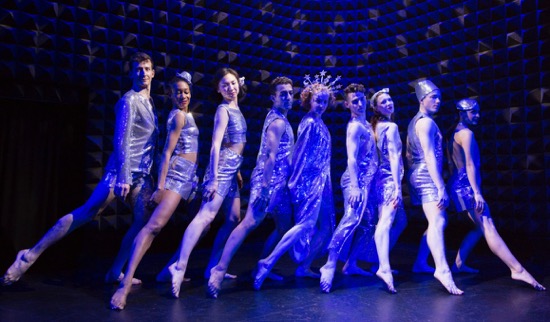
The lineup L to R: Dylan Crossman, Kristen Foote, Chelsea Hecht, John Eirich, Megan Williams, Robert Mark Burke, Esmé Boyce, Derek Crescenti, Courtney Lopes. Photo: Yi-Chun Wu
The waitpersons dole out our bills, we pay up, the performers wend through admirers. Now it’s really the end.

Thank you Deborah for telling the story that is ONE WOMAN SHOW!